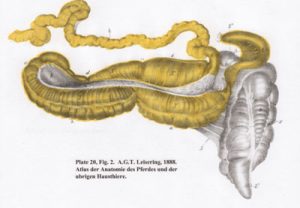Equine Colic Types
Large colon lesions
 Predispositions to disease
Predispositions to disease
Minimal fixation allows movement – colonic torsions and displacements are common
Gas production during microbial digestion may cause colic (gas distension; displacement)
Hairpin turns and changes in diameter create sites prone to impaction
Clinical signs
- Gas distension : microbes keep producing it even if physical obstruction
- Mild-severe colic : depends upon amount of gas distension
- Bloat : can see rib cage and flank distension
- Decreased fecal production
Two types of large colon disorders can reflux: nephrosplenic entrapments and small colon impactions. We believe the colon lesions are pinching the duodenum shut, creating a secondary SI obstruction.

